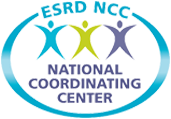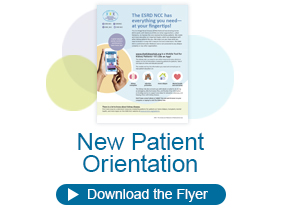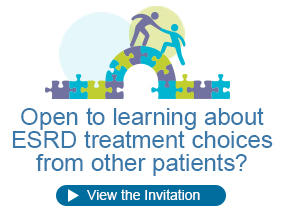The Patient Voice Drives Quality Improvement!
The National Patient and Family Engagement Learning and Action Network (NPFE-LAN) is a partnership between patients, family members, caregivers, and dialysis providers. Where patients, family and caregivers are the subject matter experts (SMEs). SMEs share their stories, ideas, and perspectives on how to improve the way things work at the facility level to improve the patient experience. They drive change across all end stage renal disease (ESRD) Networks and dialysis facilities, helping to solve shared problems on a large scale. The NPFE-LAN resources have been developed by patients for patients.
To learn more about participating in the NPFE-LAN, contact your ESRD Network.
Newly Diagnosed
- Patient Rights & Responsibilities
- Questions to Get You Started (English/Spanish)
- American Kidney Fund First 30 Program
Being Involved in Your Care
- Dialysis Choices: Choosing the Right Options for You (English/Spanish)
- Questions to Help With Your Treatment Choices (English/Spanish)
- Newly Diagnosed Renal Patient Discharge Checklist (English/Spanish)
- My Plan, My Care (English/Spanish)
- Because Your Voice Matters (English/Spanish)
- Creating a Life Plan, Pt. 1 (English/Spanish/Large Print)
- Implementing a Life Plan, Pt. 2 (English/Spanish/Large Print)
- Staying on Track With Your Life Plan, Pt.3 (English/Spanish/Large Print)
- Overcoming Barriers to Attending QAPI Meetings, Pt.2 (English/Spanish/Large Print)
- Improving Quality Outcomes: Patients' Experience, Pt. 3 (English/Spanish/Large Print)
Traveling on Dialysis
- My In-Center Dialysis Travel Checklist (English/Spanish)
- My Home Dialysis Travel Checklist (English/Spanish)
Medicare Information
- CMS Medicare Coverage of Kidney Dialysis & Kidney Transplant Services (English/Spanish)
- Dialysis Facility Compare
- Medicare for Children with ESRD
- Be Prepared for an Emergency or Natural Disaster
- Preparing for Emergencies: A Guide for People on Dialysis
- Patient Emergency Contact List
- KCER: Three-Day Emergency Diet (English/Spanish)
- Emergency Disconnet Procedure for In-Center Hemodialysis Patients (English/Spanish)
- Grievance Toolkit
- How to File a Grievance (English/Spanish)
- Considering Home Dialysis (English/Spanish)
- Choosing Home Dialysis With Your Care Team (English/Spanish)
- My Home Dialysis Checklist (English/Spanish)
- Uncovering Myths About Home Dialysis
- Options for Dialyzing at Home (English/Spanish)
- Guide to Using Telemedicine
- Preventing Peritonitis: Peritonitis Symptoms, Treatment, Prevention (English/Spanish)
- Home Dialysis: Jimmie's Story (Video)
- Home Dialysis: Delonta's Story (Video)
- Home Hemodialysis May Be the Best Option for You (English/Spanish)
- Peritoneal Dialysis May Be the Best Option for You (English/Spanish)
- Home Dialysis Poster (English/Mandarin)
- Is Home Dialysis Best for Me? (English/Spanish)
- 10 Steps to Avoid Unnecessary Hospitalizations (English/Spanish)
- Hospital Discharge Checklist (English/Spanish)
- Lab Values Quick Guide (English/Spanish/Large Print)
- Medical Appointment Tracker
- Where Should You Go for Medical Care (English/Spanish)
- Missing Treatment Domino (English/Spanish)
- Your Fluid Intake Matters! (English/Spanish)
- Engage Your Entire Care Team (English/Spanish)
- Be Prepared: Safe Hemodialysis Treatment Checklist
- Tips for Staying Healthy Outside of the Dialysis Clinic (English/Spanish)
- Guide to a Healthier You (English/Spanish)
- Patient Access Safety (English/Spanish/Large Print)
- Access Placement: What to Consider (English/Spanish)
Infection Prevention
- Pledge for Clean Hands (English/Spanish)
- Pledge for Clean Hands In You Home (English/Spanish)
- Maintaining the Immune System (English/Spanish)
- Test Your Hand Hygiene Knowledge Tutorial
- Your Infection Prevention Guide
- Planning for a Kidney Transplant (English/Spanish)
- Preparing for a Kidney Transplant (English/Spanish)
- Kidney Transplant: Protecting Your Kidney From Infection (English/Spanish)
- Kidney Transplant: Tackling Transplant Infections (English/Spanish)
- Get the Facts: Kidney Transplantation (English/Spanish)
- Partnering Along the Road to Transplant (English/Spanish)
- Turning Negatives Into Positives—Why Transplant Is a Good Idea for Me! (English/Spanish)
- Is a Kidney Transplant Right for Me?
- The Kidney Transplant Waitlist—10 Steps You Can Take to Remain Active (English/Spanish)
- How Might I Shorten My Time on the Kidney Transplant Waitlist? (English/Spanish/Mandarin)
- After Your Transplant: What to Consider (English/Spanish/Large Print)
- Transplant Bookmark (English/Spanish/Large Print)
- Preparing for Post-Transplant FAQ
Transplant 101 Series
- What Is a Kidney Transplant? (English/Spanish)
- What Is a Kidney Transplant Center? (English/Spanish)
- Meet the Members of the Transplant Team (English/Spanish)
- Types of Kidney Donors (English/Spanish)
- The Kidney Transplant Surgery (English/Spanish)
- Post-Transplant Kidney Diet (English/Spanish)
- How Much Does a Kidney Transplant Cost (English/Spanish)
- My Why—Subject Matter Experts Share Why Vaccinations Are Important to Them (Video)
- Get the Flu Shot: Not Flu (Video)
- Get the Facts About the Flu and Pneumonia Vaccine (English/Spanish)
- Immunization Card (English/Spanish)
- Vaccine Benefits (English/Spanish/Large Print)
- Vaccine Fatigue (English/Spanish/Large Print)





